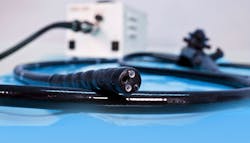In a pandemic world, endoscope care should be at or near center stage
Never forget: Even during a global pandemic, the Sterile Processing & Distribution (SPD) function, practiced by dedicated departments under a variety of names, represents one of the most important procedures in a healthcare organization.
If you deign to question or smirk at that factual and realistic observation, then try this: Send all SPD professionals home for two days on a brief paid sabbatical as an educational lesson for you.
See what happens. If you’re in the C-suite, you can expect a flurry of calls from outraged doctors and nurses. If that doesn’t electrify your malaise, wait until you see the corporate attorney’s line show up on your call list.
SPD matters.
That’s why Healthcare Purchasing News has been covering this essential, instrumental function and dedicated department of people consistently and without interruption since the late 1970s. HPN has featured the “CS/SPD Department of the Year” for the last 27 years. For five years prior to that, HPN recognized the “CS Manager of the Year.” Next month we start saluting “SPD Operations Worth Watching.” And we’ve dedicated space annually in the November edition on the topic of “Endoscope Care” for the last 16 of HPN’s 43 years in print.
Because HPN values SPD.
Historically, HPN’s annual Endoscope Care coverage explores a wide range of topics spanning the fundamental and foundational to the advanced and esoteric (for the specialized).
HPN reaches out to a wide range of subject matter experts to provide and share what you’ve come to expect to read – keen and useful insights and opinions about how to do what you do even better. This year is no exception.
On this page and on pages that follow you’ll be able to educate yourself and enjoy several stories on selected topics.
But you also can find a wealth of useful information at HPN Online. This includes a detailed feature on the key areas for continued improvement in each of the six steps in endoscope processing that HPN identifies – with the added background context of the pandemic. Visit this link: https://hpnonline.com/21157237. Further, be sure to check out HPN’s extensive coverage last year that features as an online exclusive, “The full scope of reprocessing endoscopes,” by clicking here: https://www.hpnonline.com/21110528.
Continue reading …
- Outlook Endoscopy: What’s next for endoscope reprocessing and device design? Starts Below.
- Looking ahead at endoscope reprocessing quality performance
- Techniques and tips for aeration, drying and storage
- Why ergonomics should not be over- looked
- Advance SPD to include higher-paid specialist teams
- The true colors of hydrogen peroxide sterilization chemical indicator strips
- Periscope: Color-coded standard needed for hydrogen peroxide sterilization indicator strips
- Endoscope Care in 2020 and beyond
Whether in print, online, digital or broadcast, HPN has SPD covered.
Gird yourself for endoscope product design shifts by 2030
Newer models will be more of a ripple than a tidal wave, experts predict
What’s emerging in the endoscopic technology realm is not unlike what’s been transpiring in the automotive industry.
When it comes to automobiles, consumers can choose between three types of automobiles to drive – cars that run on gasoline, cars that run on a hybrid system of electricity and gas and cars that run on electricity. In the U.S. marketplace, surveys show, by and large, that gas-powered cars represent the largest percentage, followed by hybrids and then electric-powered models.
Similarly, healthcare organizations increasingly are being given the opportunity to choose between three types of flexible and rigid endoscopes – those that are completely reusable, those that are completely disposable and those that could be called “hybrid” for infection control purposes because they are reusable devices with a select number of disposable components that can be discarded after use (e.g., distal covers and adaptors, etc.).
With the advent and emergence of minimally invasive surgical techniques back in the 1980s, surgeons routinely used reusable endoscopes in the operating room. But given the growing number of reports of cleaning, disinfection and sterilization challenges that have contributed to patient infections – some of which prove fatal in time – healthcare providers have been searching for something different.
While reinforcing education, training and certification of sterile processing professionals, switching the reporting of Sterile Processing & Distribution (SPD) to the OR, reassigning sterile processing responsibilities to dedicated Endoscopy departments, or changing the types of high-level disinfection or sterilization procedures – including technologies – may be making a difference for a variety of healthcare organizations, more are looking at the devices themselves and turning to the device manufacturers to offer solutions.
Enter alternatives to reusable models that either fully embrace the single-use concept or merely incorporate disposable components that can be swapped out even as the reusable framework remains.
Healthcare Purchasing News has been exploring the concept and emergence of single-use technology in endoscopy for several years now, locating startup companies looking to take the market by storm, but also gauging reactions of current endoscope manufacturers about this influx and potential demand shift.
Not surprisingly, endoscope manufacturers lean toward their “party line” in terms of product offerings, with the single-use product companies anticipating a complete market shift to disposables while those companies that manufacture reusable models temper their expectations, acknowledging that a minority of healthcare providers will embrace fully disposable models or reusable models with disposable components.
Further, they admit that the majority certainly are aware of and interested in the possibilities and prospects of altering their inventory mix.
HPN reached out to more than a dozen executives at manufacturers of endoscope devices and related reprocessing supplies and equipment about their forecast of any market shift during the next 10 years. They were able to choose from among five different potential market scenarios and to share their reasoning.
1. Fully reusable endoscopes will remain. Healthcare organizations will continue to rely on fully reusable flexible and rigid endoscopes for the majority of minimally invasive surgical (MIS) procedures
2. Hybrid models will become a minority segment. Healthcare organizations will increasingly shift toward using hybrid flexible and rigid endoscopes that incorporate disposable components that can be discarded after use, but the hybrid models WILL NOT surpass the use of fully reusable models
3. Hybrid models will become the majority. Healthcare organizations will increasingly shift toward using hybrid flexible and rigid endoscopes that incorporate disposable components that can be discarded after use, and the hybrid models WILL surpass the use of fully reusable models
4. Disposable/single-use only models will become a minority segment. Healthcare organizations will increasingly shift toward using fully disposable flexible and rigid endoscopes, but the disposable models WILL NOT surpass the use of fully reusable models
5. Disposable/single-use only models will become the majority. Healthcare organizations will increasingly shift toward using fully disposable flexible and rigid endoscopes, and the disposable models WILL surpass the use of fully reusable models.
Yes, SPD, there is a future
Starting with observations from more of the fringe elements, none of the executives believe that healthcare providers will continue using reusable models exclusively.
But that doesn’t mean the sterile processing function is doomed – at least for endoscopy. Why? Because reactions are mixed as to how much the use of disposable/single-use models or components will overtake the use of reusables. In fact, half the executive respondents feel hybrids are the answer while the other half supports disposable/single-use models.
This translates into the notion that reprocessing won’t be dead after all, but also that it has not quite reached the “Houston, we have a problem” stage either.
Make sway for the hybrids
More than a third (35.7 percent) feel that hybrid models – reusable endoscopes that contain disposable/single-use components – will occupy a minority segment of the market.
“Two factors limit the broad adoption of partially or fully disposable endoscopes: Psychology and economics,” Frieze explained. “Endoscope manufacturers and others are in early stages of developing disposable components, and clinicians are even earlier in the awareness and acceptance of these new options. Understandably, new product adoption can be slow in the perioperative sphere due to risk aversion. Moreover, in this case, clinicians weren’t seeking these changes; rather, they are being forced upon them by circumstances and fallout from disease outbreaks tied to flexible endoscopes.”
But Frieze observes an inherent economics issue lingers, particularly exacerbated by the pandemic.
“The economic challenge is twofold: Disposables and single-use devices are an added cost, and hospitals have been dealing with narrow margins for years, even before the disruption of the COVID-19 pandemic,” she continued. “For many decision makers, any program that adds cost (or uncertainty) will be put on the backburner considering the immediacy of managing through this public health emergency.”
MIS procedure types may experience a product shift, acknowledges Carolyn Klimas, Executive Director, Specialty Products Marketing, Olympus America Inc.
“Performance of the reusable endoscope will be superior,” he predicted.
Economics and sustainability remain litmus tests for any device migration, according to Gregg Agoston, Vice President, Business Development, SPD Transformation Services, SpecialtyCare.
Agoston stresses that “flexible endoscopes are not the only complex instruments that are reprocessed in a hospital. There are robotic instruments and countless other complex instruments with multiple parts lumens and electronics. If we cannot reprocess flexible endoscopes then we should be questioning if we can we reprocess any of these other complex instruments. Should we move to disposable for all of these instruments as well?”
Agoston refers to history – more than seven decades ago specifically – as a key discussion point.
“The current symptoms of flexible endoscopes that are not properly cleaned and prepared for surgery stem from a common root founded in the original SPD organizational model that was created in the 1940s and unfortunately has not changed to meet today’s demanding surgical instrument needs,” he indicated. “In the 1940s a movement began led by W.B. Underwood, John J. Perkins and the American College of Surgeons (ref. IAHCSMM Central Service Technical Manual) to remove instrument processing from the perioperative area to a centralized location, ‘Central Sterile Department.’ This change helped to standardize instrument processing, and it removed the responsibility of instrument processing from the nurses, allowing them more time with their patients.”
Back then, surgical instruments largely would be considered “non-complex” by today’s standards, Agoston continued. They consisted primarily of stainless steel devices used for cutting, grasping, dissecting, etc., along with basins and glassware.
“The staff for the newly created Central Sterile Processing Department often were promoted from dietary services since the functions of cleaning were seen as similar,” Agoston recalled. “Pay was a step up from dietary pay. Lost in this transition was the knowledge that the nursing staff had of how the instruments were used and their relative importance to the successful surgical procedure. SPD staff were expected have the capability to clean, inspect, assemble and sterilize all items that came through the department. This model worked primarily because of the simplicity of the instruments and relatively few instrument sets the department was responsible for.”
Advanced surgical procedures began to emerge and grow, Agoston posits, and pressurized the 1940s SPD model.
“Fast forward to today’s advanced surgical procedures that require complex instruments – endoscopes, cameras, power tools, robotic instruments, Orthopedic/Neuro/Spine, etc.,” he continued. “These procedures could only be dreamed about in 1940. The associated skills needed for cleaning, inspection and sterilization of these complex instruments is much higher compared to the skills needed for non-complex instruments. Instructions for Use (IFU) went from one page of cleaning instructions to 37-plus pages for a robotic instrument, and over 100 pages for a flexible endoscope.
“With hundreds of hospital- and vendor-owned instruments/sets being processed daily, the importance of a highly productive and effective SPD is just as important to the success of the surgical procedure as are the surgeons, anesthesiologists and nurses,” Agoston insisted. [Editor’s Note: Agoston shares his vision of a solution in the sidebar, Advance SPD to include higher-paid specialist teams on page 40]
Others foresee a more pervasive embrace of hybrid devices. In fact, a smaller segment (14.3 percent) argues that hybrids will be used by the majority.
But Hendee stops short of recommending full conversion to disposable/single-use devices.
“This might lead you to think I would prefer a fully disposable endoscope, but I do not,” Hendee clarified. “Solving processing issues would be a great leap forward for these devices but could cause others. Adding multiple disposable endoscopes each day to a facility’s waste stream is a cost and environmental concern. On the other hand, if only certain components were disposed of, processing outcomes could be improved, and other impacts could be minimized. I believe this win will drive Hybrid endoscopes to eclipse fully reusable models.”
“The scope should be redesigned to have disposable section that comes into contact with patient (insertion section),” Azizi asserted. “The electronic and control can remain reusable and sterilizable. This will be the safest for patient, the most cost-effective and environmentally friendly approach.”
SUDs make waves
More than one-fifth (21.4 percent) predict fully disposable/single-use devices will be added to a provider’s inventory stream, but not dominate what surgeons use.
“The move will be evident, and a contributing driver [will] be reported endoscope-related infections,” McGinty predicted. “Identification and tracking of infections to endoscopes is inconsistent, however. Industry will continue to develop single-use models that will ‘make sense’ to infection prevention-minded consumers to replace their reusable inventory.”
Natalie Reece, Endoscopy Clinical Educator, Key Surgical, casts doubt on the cost argument.
“For example, a study from last year titled, ‘Reusable Flexible Ureterorenoscopes are more cost-effective than single-use scopes: results of a systemic review from PETRA uro-group’ by Talso, et Al., found that, depending on the number of uses per repair (which varied between 8-29 procedures per repair), the cost per procedure for a scope was anywhere between $120 and $1,200 per procedure,.” she explained. “They say, ‘A significant trend was observed between the decreasing cost of repair with the number of usages,’ meaning the more usages you got before you needed to send out for repair, the cheaper overall that reusable scope would be for your procedures. They compare this with a couple other disposable ureterorenoscopes that cost $700, $1,500 or even $2,000 dollars a pop.”
Reece refers to an Ofstead & Associates research study published three years ago that examined 20 different scopes at three different sites, finding that all endoscopes had visible irregularities.
“What this tells us is that we’re currently not sending out our scopes for repair enough,” Reece argued. “The cost of repair per procedure should be so much higher, meaning that reusable scopes are not necessarily cheaper than disposable.” She cites another Ofstead study that investigated all of the variables involved in reprocessing, including the water, chemicals, PPE, salaries, time and other resources.
“For these reasons, I think most facilities will find that not only are disposable scopes just as good as reusable [scopes] during a procedure, but the quick set-up and low cost (compared to the actual true cost of reprocessing) will make them a no brainer,” she added.
But Reece remains realistic about progress.
“This is healthcare, however, and making changes is often like moving mountains,” she said. “The change is slow and takes time. Oftentimes the silos between decision makers prevent the necessary dot connecting that is needed in order to make the systemic change toward disposable scopes. Overtime, those who pay out for treating HAIs will incorporate their cost into the mix, and we’ll see that disposable scopes are a no brainer. Lastly, I believe that as these become more prevalent, vendors will be encouraged – or maybe even required; a girl can dream! – to design scopes that have recyclable components and have a smaller footprint on our landfills, though the likelihood of this happening in 10 years is slim.”
Mobile Instrument Service & Repair’s Clinical Education and Training Manager Melissa Kubach, homes in on performance quality perceptions.
“We have yet to see widespread adoption of disposable scopes largely because they do not match the performance of reusable scopes at a price point that allows for substitution,” Kubach noted. “As quality and user experience improve, disposables will capture market share, provided the cost compares favorably to reusable scopes. Comparable image, performance and maneuverability are important. Loss of technology, such as near focus, specialty light wave applications and endoscope position monitoring may play a role as well. Reimbursement is key, especially when you are requesting insurance companies to cover cost for which they were not historically responsible.
“Considerations of a known safe reusable alternative method may be appealing for higher-risk duodenoscopes but other common models may not make the cut,” she concluded.
Yet others anticipate the tide turning more dramatically.
“Where possible, single-use endoscopes will continue to offer significant productivity and cost-management benefits for hospitals – much the way that other areas in the hospital have long since moved from reusable equipment to fully disposable to enable greater efficiencies and patient safety,” Escobar indicated. “This shift will alleviate the potential for device cross-contamination and ensure that each patient has a sterile device used on their procedure. This is highly advantageous to healthcare leaders, such as infection preventionists and healthcare risk managers. Not only will it free SPD to focus energies and investments in reprocessing devices that cannot be disposable, it will also enable hospitals to reduce the extensive investment in purchasing and maintaining reusable endoscopes. These devices require an incredible amount of resources to ensure they are ready in a timely manner and adequately prepared for safe use on the next patient.”
By Integrated Endoscopy’s measure, the gate has been opened.
Cripe cites as examples single-use shaver blades in arthroscopy, single-use pressure transducers in cardiac medicine and even syringes, depending on how far back one traces. “The costs associated with repair, processing, sterilization and OR down-time are some of the key drivers to the rigid endoscopy conversion as well as the performance degradation over time, which is the direct result of processing and sterilization,” he added.
“In the near term, we see synergies and complementariness between reusable and single-use devices,” Lord noted. “But in the medium and longer term, we believe the market will consistently migrate fully to single-use devices. When you can combine high-definition visualization without the headaches, expense or risk of reusable endoscopic platforms, once you experience the benefits, there’s really no reason to go back. Is anyone today begging to go back to 35mm film cameras when we have our high-quality iPhone cameras in our pocket?”
Lord extols additional benefits single-use models can bring. “Complicated vendor contracts put the risk of obsolescence on the customer,” he indicated. “Pristine Surgical’s high-definition digital platform is scalable and extendable, eliminating the risk of obsolescence – and the software and hardware can be seamlessly upgraded without further capital expenditure.”
“First, as disposable products continue to be developed, the cost will become more competitive,” she surmised. “This will impact the price barrier that many facilities have and make the product more appealing. Another issue with disposables is picture quality. I think disposable products will continue to evolve and have better picture quality, or have a range of picture quality options with different price points. Another issue to be considered with any disposable item is the environmental impact. Many companies offer recycling programs for various products. If this is feasible with disposable scopes, it would be an enticing option to reduce the environmental impact and decrease prices.”
Sonstelie acknowledges that hybrid models, equipped with disposable components for critical areas of the endoscope, such as distal tips and elevator mechanisms, may offer an alternative to continue operating in the current state. But she classifies it as more of a transitional role.
“There are too many infections and risks to patient safety with some current reusable models,” she insisted. “Additionally, we know that some scopes cannot be cleaned effectively, even when following the IFU. If we convert these critical components to disposables, there are still parts of the scope that remain difficult to clean and inspect. For example, the channels can be damaged and harbor bioburden, creating a patient safety risk. I think having disposable components for the most critical areas of the endoscope is only a partial or temporary solution.”
About the Author
Rick Dana Barlow
Senior Editor
Rick Dana Barlow is Senior Editor for Healthcare Purchasing News, an Endeavor Business Media publication. He can be reached at [email protected].













